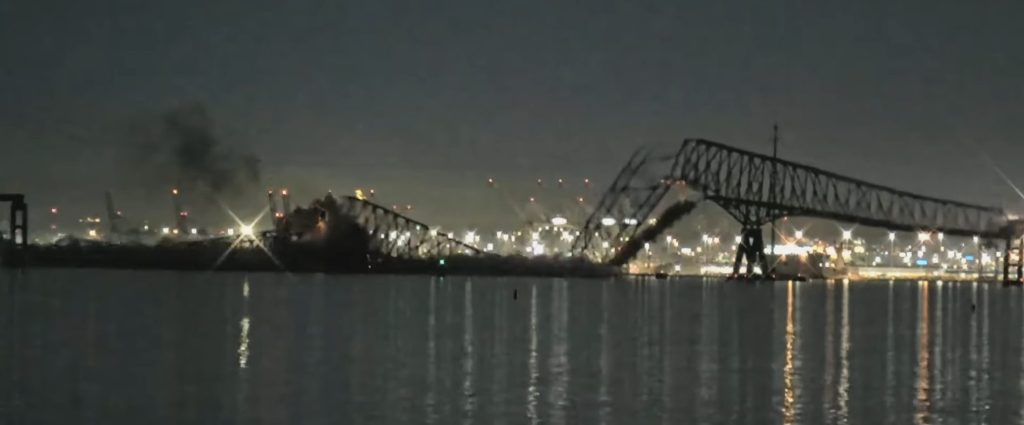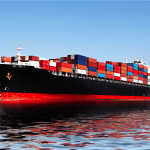Container Ship Crashes into Baltimore Bridge and Collapses It – 6 People Missing in Water, Port of Baltimore Closed
Early this morning, a container ship called the Dali left the Port of Baltimore for Sri Lanka, but things went horribly wrong. About a half hour later, the ship lost power and crashed into the Francis Scott Key Bridge. The ship damaged the support pillar it struck so badly the entire structural integrity of the bridge was destroyed. The bridge collapsed into the Patapsco River. A rescue mission is underway to find people who were plunged into the water with it.
The Key Bridge collapse was caught on camera:
Matt Mathers, Tom Watling, and Martha McHardy reported in the Independent that a mayday call from the ship after it lost power saved lives:
It is still unclear what caused the accident at this time, but Maryland Governor Wes Moore said that the ship made a mayday call just ahead of the accident. Some crew aboard the ship told authorities they lost power moments beforehand.
The call gave people on the bridge enough time to prevent cars from continuing on the bridge, saving lives.
It sounds like things could have been much worse, but people still ended up in the water. The Independent article continues:
… eight individuals are believed to have fallen in the water. Two individuals were rescued and one is currently in the hospital.
Reporting from various outlets says those individuals had been on the bridge in their cars, Ariana Baio, in another article from the Independent, reported those individuals plunged into the water are believed to be construction workers.
Collapse Shuts Down the Port of Baltimore

On the international shipping side of things, the collapsed bridge cuts off ship access to and from the Port of Baltimore, thus, forcing the port closed, at least to ship traffic.
Joe Antoshak and John Kingston reported in a FreightWaves article:
The Port of Baltimore announced at approximately 8 a.m. Eastern that it was closed for inbound and outbound vessel traffic. It did say that truck operations at terminals inside the port would continue.
But the bridge collapse effectively sets up a wall between the port and Chesapeake Bay. There does not appear to be any other inbound or outbound way between the port and shipping lanes, raising the question of how long this key terminal will be closed.
Trucking shipping containers of goods away from the port will likely be a mess of congestion, which will also be a problem for commuters. Here’s a taste of the logistical complications from the FreightWaves article:
The Maryland Transportation Authority is advising against the use of Interstate 695, a key route for Baltimore’s commuters and freight movement, following the collapse. The bridge plays a vital role in commercial shipping access to the Port of Baltimore, a major hub for autos, light trucks and various bulk goods. It is the easternmost way of getting across the Port of Baltimore.
…
Alternate routes for trucks that bypass the Key bridge are a tunnel on Interstate 895 under the Baltimore Harbor, a tunnel on Interstate 95 under the harbor, or Interstate 695 on the west side of Baltimore. The bridge is part of Interstate 695, the Baltimore Loop, on the east side of the city.
The Maryland Transportation Authority on its X feed, noted that vehicles transporting hazardous materials may not use either the I-95 (Fort McHenry) or I-895 (Baltimore Harbor) tunnels. To get around Baltimore, they will need to use I-695 on the western side of the city.
Additionally, MDTA said on X that vehicles in excess of 13 feet, 6 inches in height or 8 feet in width are prohibited from using the Baltimore Harbor Tunnel on I-895. For the Fort McHenry Tunnel, which is part of I-95 through the heart of Baltimore, the limits are 14 feet 6 inches in height and 11 feet in width.
Paul Wiedefeld, Maryland’s transportation secretary, said the water where the bridge was struck is about 50 feet deep, complicating search-and-rescue operations. The U.S. Coast Guard and dive teams are currently searching for survivors, with Baltimore’s fire chief noting the additional challenges posed by the water’s current.
The Port of Baltimore is a major U.S. port; Harry Fletcher pulled some data in an Indy100 article about the devastating accident to show how much cargo moves through it:
Last year was a record year for the port itself in terms of cargo. As Transport Topics reports, the Port of Baltimore’s public marine terminals hit a record high for receiving 11.6 million tons of general cargo in the fiscal year of 2023 – up from a high of 11 million tons in 2019.
Details About the Ship
As mentioned above, the name of the ship that hit the Key Bridge is the Dali. It’s owned by Grace Ocean Private Ltd, operated by Synergy Group, but chartered by Maersk. Baio reported in her Independent article:
The vessel was chartered by Maersk to carry Maersk’s customer’s cargo from Baltimore to Colombo in a nearly month-long journey, according to a statement from the company.
…
All the crew members, including the two pilots, have been accounted for and there are no reports of any injuries onboard, according to the Synergy Group.
Maersk said none of its crew or personnel were on board the vessel when the incident occurred.
There were, however, 4,900 shipping containers onboard, according to the FreightWaves article. The importance of cargo insurance now comes into play as the process of assessing the damage and loss of goods begins.
Of course, the most important part of this whole story is the lives of the people who fell into the Patapsco River. Thank God it wasn’t even worse with the loss of lives to the crew or the motorists who were kept off the bridge because of the mayday call.





